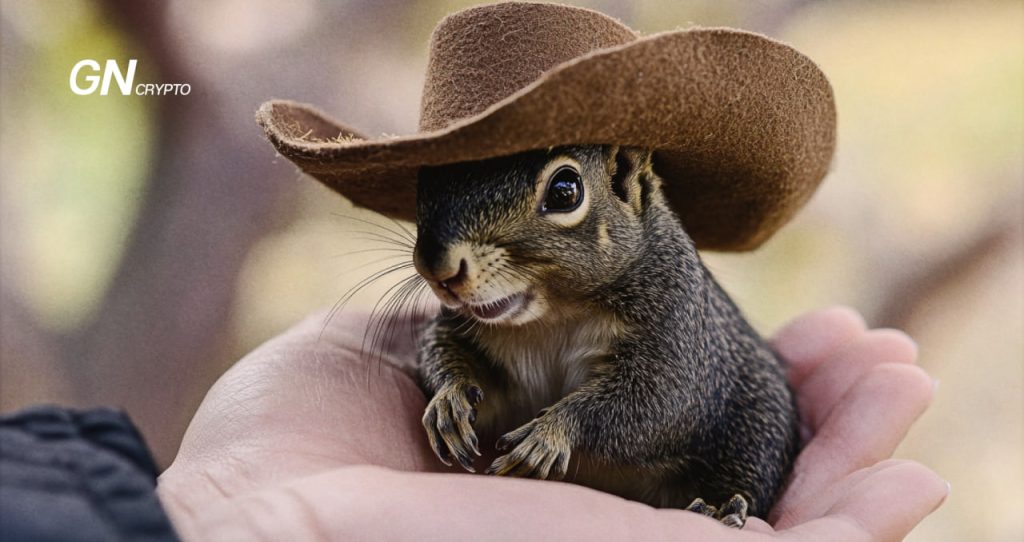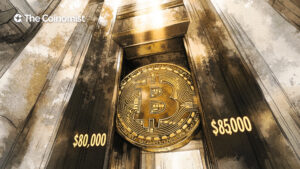What Is PNUT Memecoin and What’s the Story Behind It?

Lately, in mid-November 2024, Peanut the Squirrel (PNUT) memecoin took off. It easily stands out on price charts with its price surge of around 1,400% in a week.
On this page
What’s driving the price increase, how long will PNUT maintain its position, and what is the memecoin’s backstory? Keep reading to find out.
The Sad Story Behind the Memecoin: What Happened to Peanut the Squirrel?
PNUT was created to honor Peanut the Squirrel, a beloved pet who, along with Fred the Raccoon, was taken away by his owner, Mark Longo, and euthanized. Peanut's story went viral on the internet, raising concerns about animal protection.
Longo rescued Peanut seven years ago after finding the animal on the street. He witnessed Peanut’s mother being hit by a car and took the baby squirrel into his care.In a video recounting how he decided to keep Peanut, Longo shared that he initially contacted rehabbers to see where he could leave the squirrel but was told the baby would most likely be euthanized.
Thus, Longo decided to care for Peanut until he recovered and could be released. However, when the time came, Peanut chose to return, and it became clear that the squirrel was going to stay home.
Later, Longo created social media accounts to share videos of Peanut’s daily life. He also founded an animal rescue fund called “Peanut’s Freedom Farm” to provide care for over 300 animals in their sanctuary.
The squirrel lived with Longo for 7 years.
Then, on October 31, 2024, officers from the Department of Environmental Conservation (DEC) in New York unexpectedly showed up at Mark’s house with search warrants for a raid. They claimed to have received anonymous complaints concerning the potential risk of rabies the animals might have posed.
The agency seized Peanut and Fred the raccoon.
The most tragic part of the story is that the DEC euthanized the animals afterward. According to the agency, one of the officials had been bitten by the squirrel, and in order to test for rabies, they claimed the only method was to euthanize the animal.
However, many concerned individuals – including the animals' owners – believe this could have been easily avoided.
First, officials could have used safety measures to prevent the squirrel from biting, as it was likely frightened after being taken from its home.
Next, rabid animals typically show symptoms, and once infected, they live no more than a couple of weeks. Peanut and Fred had lived indoors for years, which greatly reduced the likelihood of them contracting the disease in the wild.
The test results for both animals came back negative for rabies.
“Justice for Peanut:” The Story Has Become Massive
Soon after the story became known, the hashtag #JusticeForPeanut went viral on X, with users expressing their support for Longo. In their social media posts, people criticized the government for the way they treated the pets.
Now-President-elect Donald Trump and Tesla CEO Elon Musk were among those who raised questions about the government's power over domestic animals and whether animal rights are adequately protected in the US.
During the presidential campaign, VP-elect James David Vance said Trump was “fired up” about the squirrel’s death. In his words:
The same government that doesn't care about hundreds of thousands of illegal immigrant criminals coming into our country, doesn't want us to have pets. It's the craziest thing.
Elon Musk discussed Peanut the Squirrel during a podcast with Joe Rogan, saying that America couldn’t truly be called a land of the free if the government could break into people’s homes and take their pets.
Musk encouraged people to vote for Donald Trump and fight back against the current government. According to him, the squirrel had become a symbol of liberty, a message he shared on X.
From political controversy to public attention, the story of Peanut and Fred gained widespread popularity. On GoFundMe, P'Nuts Freedom Farm organized on behalf of Mark Longo raised over $230,000 from donors to support animal rescue efforts.
In recent updates, Longo told WETM 18 news they are going to file a lawsuit against the DEC. He mentioned that the sanctuary will continue its operations, as they have an obligation to care for 300 animals.
Meanwhile, the DEC stated that they have launched an internal investigation. However, Longo expressed doubt about the investigation's effectiveness.
The PNUT Memecoin and Its Explosive Growth
In the memecoins category, cryptocurrencies are often linked to trending news, popular animals, politics, and various other themes.
PNUT was created in memory of Peanut the Squirrel. Launched on Solana on October 21 through Pump.fun, the memecoin began with a supply of 1 billion tokens. It features a burning mechanism, where a portion of the tokens is permanently removed from circulation.
PNUT became the second memecoin launched on Pump.fun to hit a $1 billion market cap within just 13 days.
There are a few reasons behind PNUT's growth: people’s emotional connection to the story, Elon Musk’s social media posts about Peanut, the Binance listing, and the usual trend in the memecoin world to make a profit from coins tied to big news.
On November 11, Binance, the largest crypto exchange by trading volume, announced it was listing PNUT.
Then, on November 13, Elon Musk’s post on X helped drive the price even higher. It was a reply to Ashley St. Chair, an author who criticized the political moves after Trump’s win and the new DOGE department (Department of Government Efficiency) to be led by Musk, saying it looked like “programmed entertainment.”
In response, Musk tweeted: “America was saved by a squirrel and a memecoin.”
After the news about Binance and posts from Musk, PNUT saw a massive 3,000% price surge in just one week, reaching an all-time high of $2.47 on November 14, 2024.
The coin currently trades at around $1.90. This explosive growth has propelled PNUT into the top 100 largest cryptocurrencies by market cap, which now stands at over $1.8 billion.
PNUT’s price from November 5 to November 15. Source: coinmarketcap.com
For Peanut or For Profit? The Risky Side of Memecoins
Memecoins are among the most controversial assets in the crypto space. One day they can be on top of the charts, and the next they can fall, often driven by their relevance and people's interest. A common trend in the memecoin sector is that when one coin succeeds, or a new buzzworthy topic emerges, many similar cryptocurrencies flood the market.
For example, if you search for “Peanut” on Pump.fun, you’ll find a number of Peanut-inspired memecoins alongside the original. While this can help raise awareness, it might confuse investors.
To identify the original PNUT, look at its market cap and creation date—just 15 days ago. Checking the wallet address of PNUT’s creator on Solscan shows a balance of 3.6 SOL (around $776) despite the coin's surge.
The PNUT Developer’s address balance. Source: solscan.io
On-chain analytics platform Lookonchain shared insights about PNUT’s token distribution. According to the platform, the “holdings distribution is healthy, with no obvious connections between most large holders.”
Lookonchain also noted that large investors are purchasing the coin, with one address spending 9,600 SOL (around $1.56M) to buy both $PNUT and $FRED memecoins.
Although no red flags have been identified in PNUT’s analysis, trading memecoins is inherently risky. This is why we agree with Lookonchain’s conclusion from a recent Twitter thread:
Trading #MEMEcoins is extremely dangerous, please do your own research.
Memecoin Growth in 2024: Which Memecoins Are the Most Popular:
Memecoins have been a leading category in 2024. Currently, the total market cap of all memecoins exceeds $112 billion, up from $23 billion at the start of the year. The daily trading volume of memecoins is above $43 billion as of November 15.
Market cap and trading volume of memecoins over the last year. Source: coinmarketcap.com
The main factors driving the growth of memecoins are strong community support, easy production, and their relevance to internet memes and trending news.
Related: What’s the Secret to Memecoin Popularity?
Among the most popular memecoins currently are:
Dogecoin (DOGE)
Market cap: $55.3 bln
Dogecoin was launched in 2013 as a parody of Bitcoin, inspired by the viral “Doge” Shiba Inu meme. Despite its comedic origin, it gained popularity for its use in tipping and donations on social media platforms. Dogecoin operates on its blockchain and uses a Proof-of-Work (PoW) consensus. It gained mainstream attention with endorsements from high-profile figures like Elon Musk, who dubbed it the “people’s crypto.”
Shiba Inu (SHIB)
Market cap: $14.3 bln
Dubbed the “Dogecoin killer,” Shiba Inu launched in 2020 on the Ethereum blockchain. Unlike Dogecoin, SHIB supports an ecosystem that includes decentralized finance (DeFi) applications and non-fungible tokens (NFTs). Its ecosystem consists of tokens like LEASH and BONE and a decentralized exchange called ShibaSwap. The project’s focus on community-driven growth and utility has made it a prominent player in the memecoin space.
Pepe (PEPE)
Market cap: $9.3 bln
Inspired by the internet-famous “Pepe the Frog” meme, PEPE entered the crypto scene in 2023. It gained rapid traction due to its nostalgic appeal and high volatility, making it a favorite for speculative traders. PEPE doesn’t currently offer significant utility but thrives on community-driven hype and its association with one of the internet's most enduring memes.
Dogwifhat (WIF)
Market cap: $3.6 bln
Dogwifhat is a niche memecoin featuring a whimsical mascot: a dog wearing a hat. It captures the playful essence of memecoins with an emphasis on humor and viral potential. While its market presence is smaller compared to DOGE and SHIB, its quirky branding and low entry price attract meme enthusiasts and first-time investors.
Bonk (BONK)
Market cap: $2.8 bln
Bonk launched in late 2022 as the first dog-themed memecoin on the Solana blockchain. It aims to revitalize the Solana ecosystem with a focus on community engagement. BONK distributed a portion of its tokens as airdrops to Solana users, generating buzz and rewarding loyal blockchain participants. Known for its high-speed transactions and low fees, BONK highlights the potential of Solana as a competitive blockchain for memecoins.
FAQ
- What Is Peanut the Squirrel (PNUT) memecoin?
Peanut the Squirrel (PNUT) is a memecoin built on the Solana blockchain. It was created in memory of Peanut, a pet squirrel who gained internet fame for performing tricks and wearing hats. Following Peanut's controversial euthanasia by authorities, the incident triggered significant public outrage and inspired the creation of the PNUT memecoin.
- Why Has the PNUT Price Surged?
PNUT's price surged due to widespread attention following Peanut's story, listing on crypto exchanges and Elon Musk’s posts related to the story.
- What Are Other Popular Memecoins?
Other popular memecoins include Dogecoin (DOGE), Shiba Inu (SHIB), Pepe (PEPE), Bonk (BONK), and others.
- Is It Safe to Invest in Memecoins?
Investing in memecoins is highly speculative and risky. While some coins can yield massive short-term gains, they often lack intrinsic value and can be influenced by market hype. It's essential to conduct thorough research and only invest what you can afford to lose.
The content on The Coinomist is for informational purposes only and should not be interpreted as financial advice. While we strive to provide accurate and up-to-date information, we do not guarantee the accuracy, completeness, or reliability of any content. Neither we accept liability for any errors or omissions in the information provided or for any financial losses incurred as a result of relying on this information. Actions based on this content are at your own risk. Always do your own research and consult a professional. See our Terms, Privacy Policy, and Disclaimers for more details.


























